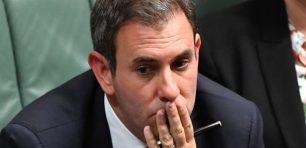
Treasurer Jim Chalmers. Source: AAP/Joel Carrett.
Treasurer Jim Chalmers last week confirmed he will borrow from New Zealand’s “wellbeing budget” model for his first budget in October, after he floated the possibility in 2020.
NZ Prime Minister Jacinda Ardern and her Finance Minister Grant Robertson introduced this new approach in 2019, claiming it was the first budget of its kind in the world. The key difference to traditional budgets lies in the measurements used — projecting not just jobs, gross domestic product (GDP) and public debt, but also mental health outcomes, environmental sustainability, social inclusion and more. These measurements are used by Ardern’s ministers to prioritise which items get funded, and in the budget’s projections of how these policies will impact the nation.
How will this approach translate to the Australian context? And will it entail changes to Albanese’s policy suite? For insights, let’s look at how it has worked elsewhere.
It’s not just an NZ thing
While being billed as a Kiwi import, similar approaches have been tried farther afield — and in our own backyard.
Former UK prime minister David Cameron and former French president Nicolas Sarkozy — both conservative leaders — established commissions to investigate better ways to measure social progress in the wake of the global financial crisis.
The United Arab Emirates went a step further, appointing a minister of state for happiness to administer a National Programme for Happiness and Positivity, while Bhutan measures Gross National Happiness.
Prior to all of these innovations, Australia’s own Treasury department pioneered a “wellbeing framework” under Ken Henry’s leadership, which incorporated “voluntary work, personal and professional relationships, the quality of the physical environment, education, health and leisure”. It also acknowledged “the higher value of an extra dollar to a poor person versus a rich person”.
These efforts were based on an increasing acknowledgement of the limitations of GDP as a headline measurement of societal progress. As economist Richard Holden wrote for The Conversation, GDP is “both under-inclusive in that it fails to account for non-market production … including childcare and breastmilk, and over-inclusive in that it treats pollution, carbon emissions … as good even if their effects are bad”. Mind you, improving social outcomes often does increase GDP too, but it’s better to measure it at the source.
These efforts to better “measure what matters” ran out of steam, largely due to changes of government. In Australia, Tony Abbott-appointed Treasury secretary John Fraser ditched our wellbeing framework, telling a 2016 Senate hearing that he wrote a replacement framework “between 6 and 8:30pm one night, as I was waiting to go out to dinner”. Its sole metrics: “jobs and growth”.
Ardern’s wellbeing push produced mixed results
Ardern’s government has shown a firmer commitment to broadening the definition of budgetary success, delivering four “wellbeing budgets” so far measured against five priorities: “taking mental health seriously, improving child wellbeing, supporting Māori and Pasifika aspirations, building a productive nation and transforming the economy [for a low-emissions future]”.
But whether her budgetary approach has facilitated improvements in these areas remains contentious. Some see it as mere window dressing. “It was marketing as opposed to substance,” Arthur Grimes, Professor of wellbeing and public policy at Victoria University of Wellington, is quoted as saying in The Guardian. Indeed, NZ faces an escalating housing crisis and Ardern’s bold child poverty targets haven’t all been met, while the government remains committed to returning the budget to surplus.
Mind you, the pandemic proved a difficult setback on various indicators of wellbeing. Given the circumstances, some are glad merely not to have gone steeply backwards. And Ardern’s government, after an underwhelming start, has recently made bolder moves on welfare payments, unemployment insurance and workers’ rights, which may reap results in future wellbeing reports.
The proof is in the policy
Ardern’s mixed record underscores a key takeaway for Aussies — better measuring of societal wellbeing is worthwhile, but it doesn’t necessarily improve it. At best, making cabinet ministers read figures on how policies they’re considering might impact social equity, environmental health and mental wellbeing might make them rethink regressive options. And injecting such priorities into the media spectacle on budget night may help remind punters that budgets aren’t merely bean-counter exercises, which could help build momentum for social change.
But it will not do the grunt work of developing and implementing successful policies for you.
It could, however, change the media narrative over time and raise the urgency of social and environmental problems, opening space for the Albanese government to expand its agenda after a relentlessly “small-target” campaign saw it jettison various policies that would have undoubtedly enhanced societal wellbeing.
With a majority in the lower house — something Ardern didn’t have in her first term — Labor must make the case for progressive reform, then act decisively. It’s the only way to make the lines that matter trend upwards.
This article was first published by Crikey.
Handpicked for you

ANZ and Westpac face discrimination complaints for ‘debanking’ small businesses



COMMENTS
SmartCompany is committed to hosting lively discussions. Help us keep the conversation useful, interesting and welcoming. We aim to publish comments quickly in the interest of promoting robust conversation, but we’re a small team and we deploy filters to protect against legal risk. Occasionally your comment may be held up while it is being reviewed, but we’re working as fast as we can to keep the conversation rolling.
The SmartCompany comment section is members-only content. Please subscribe to leave a comment.
The SmartCompany comment section is members-only content. Please login to leave a comment.